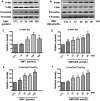Dihydromyricetin protects HUVECs of oxidative damage induced by sodium nitroprusside through activating PI3K/Akt/FoxO3a signalling pathway
- PMID: 31111658
- PMCID: PMC6584490
- DOI: 10.1111/jcmm.14406
Dihydromyricetin protects HUVECs of oxidative damage induced by sodium nitroprusside through activating PI3K/Akt/FoxO3a signalling pathway
Abstract
The damage of vascular endothelial cells induced by oxidative stress plays an important role in the pathogenesis of atherosclerosis. Dihydromyricetin (DMY) is considered as a natural antioxidant. However, the mechanism of DMY on endothelial cell injury induced by oxidative stress remains unclear. In this study, we found that DMY could reduce the oxidative damage of HUVECs induced by sodium nitroprusside (SNP), HUVECs pre-treated with DMY suppressed SNP-induced apoptosis by reduced ROS overproduction of intracellular, decreased MDA level and elevated the superoxide dismutase activity. Meanwhile, we found that DMY could promote the expression of phosphorylated FoxO3a and Akt, and affect the nuclear localization of FoxO3a, when treated with the PI3K inhibitor LY294002, the effect of DMY was blocked. These data suggest that DMY protects HUVECs from oxidative stress by activating PI3K/Akt/FoxO3a signalling pathway. Therefore, DMY may have great therapeutic potential as a new drug for atherosclerosis.
Keywords: apoptosis; atherosclerosis; dihydromyricetin; oxidative stress; sodium nitroprusside.
© 2019 The Authors. Journal of Cellular and Molecular Medicine published by John Wiley & Sons Ltd and Foundation for Cellular and Molecular Medicine.
Conflict of interest statement
The authors declare no conflict of interest.
Figures









Similar articles
-
FGF21 protects human umbilical vein endothelial cells against high glucose-induced apoptosis via PI3K/Akt/Fox3a signaling pathway.J Diabetes Complications. 2018 Aug;32(8):729-736. doi: 10.1016/j.jdiacomp.2018.05.012. Epub 2018 May 25. J Diabetes Complications. 2018. PMID: 29907326
-
Dihydromyricetin protects human umbilical vein endothelial cells from injury through ERK and Akt mediated Nrf2/HO-1 signaling pathway.Apoptosis. 2017 Aug;22(8):1013-1024. doi: 10.1007/s10495-017-1381-3. Apoptosis. 2017. PMID: 28612103
-
[Protective effect and mechanisms of dihydromyricetin on PC12 cells induced by oxidative injury].Zhong Yao Cai. 2014 Jun;37(6):1014-20. Zhong Yao Cai. 2014. PMID: 25470969 Chinese.
-
Recent update on application of dihydromyricetin in metabolic related diseases.Biomed Pharmacother. 2022 Apr;148:112771. doi: 10.1016/j.biopha.2022.112771. Epub 2022 Mar 2. Biomed Pharmacother. 2022. PMID: 35247719 Review.
-
Dihydromyricetin: A review on identification and quantification methods, biological activities, chemical stability, metabolism and approaches to enhance its bioavailability.Trends Food Sci Technol. 2019 Sep;91:586-597. doi: 10.1016/j.tifs.2019.07.038. Epub 2019 Jul 25. Trends Food Sci Technol. 2019. PMID: 32288229 Free PMC article. Review.
Cited by
-
Dihydromyricetin Alleviates H9C2 Cell Apoptosis and Autophagy by Regulating CircHIPK3 Expression and PI3K/AKT/mTOR Pathway.Chin J Integr Med. 2023 May;29(5):434-440. doi: 10.1007/s11655-022-3687-4. Epub 2022 Dec 7. Chin J Integr Med. 2023. PMID: 36474083
-
Pharmacological mechanisms and potential clinical applications of Dihydromyricetin in neurological disorders.Front Pharmacol. 2025 Jul 16;16:1618623. doi: 10.3389/fphar.2025.1618623. eCollection 2025. Front Pharmacol. 2025. PMID: 40740995 Free PMC article. Review.
-
Dihydromyricetin: an emerging compound with comprehensive effects on multiple systems.Front Pharmacol. 2025 Jan 3;15:1488003. doi: 10.3389/fphar.2024.1488003. eCollection 2024. Front Pharmacol. 2025. PMID: 39830336 Free PMC article. Review.
-
CTLA4-Ig protects tacrolimus-induced oxidative stress via inhibiting the AKT/FOXO3 signaling pathway in rats.Korean J Intern Med. 2023 May;38(3):393-405. doi: 10.3904/kjim.2022.293. Epub 2023 Apr 28. Korean J Intern Med. 2023. PMID: 37157174 Free PMC article.
-
Mechanisms of dihydromyricetin against hepatocellular carcinoma elucidated by network pharmacology combined with experimental validation.Pharm Biol. 2023 Dec;61(1):1108-1119. doi: 10.1080/13880209.2023.2234000. Pharm Biol. 2023. PMID: 37462387 Free PMC article.
References
-
- Mozaffarian . Heart disease and stroke statistics‐2015 update: A report from the American heart association. Circulation. 2015; 131: E535. - PubMed
-
- Bentzon JF, Otsuka F, Virmani R, Falk E. Mechanisms of plaque formation and rupture. Circ Res. 2014;114:1852‐1866. - PubMed
-
- Dernbach E, Urbich C, Brandes RP, Hofmann WK, Zeiher AM, Dimmeler S. Antioxidative stress‐associated genes in circulating progenitor cells: evidence for enhanced resistance against oxidative stress. Blood. 2004;104:3591‐3597. - PubMed
-
- Higashi Y, Noma K, Yoshizumi M, Kihara Y. Endothelial function and oxidative stress in cardiovascular diseases. Circ J. 2009;73:411‐418. - PubMed
Publication types
MeSH terms
Substances
LinkOut - more resources
Full Text Sources
Research Materials

